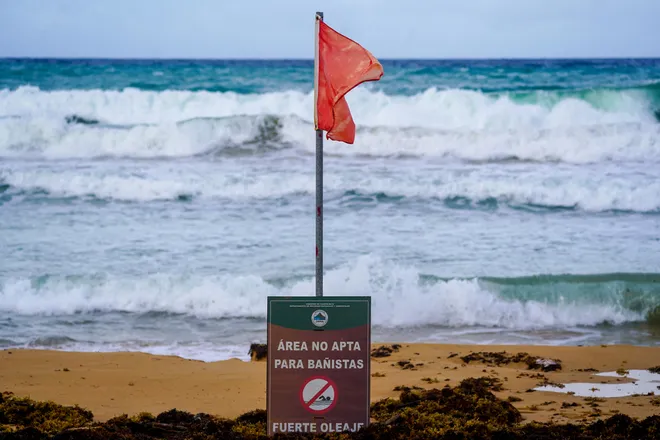Ernesto intensifies into Category 1 hurricane north of Puerto Rico
Ernesto intensified into a Category 1 hurricane Wednesday as it churned north of Puerto Rico, where it unleashed torrential rain and damaging winds that triggered flash flood warnings and cut power to over a half-million homes and businesses.
As of 11 a.m. ET, Ernesto was located 175 miles northwest of San Juan, Puerto Rico, with sustained winds of 75 mph, according to the National Hurricane Center.
The storm pummeled Puerto Rico and the Virgin Islands through the morning, quickly dumping several inches of rain across the territory, leading forecasters with the National Weather Service in San Juan to warn of "life threatening flash flooding." All told, the U.S. and British Virgin Islands could see widespread rainfall totals of 6 inches, while the total for southeastern Puerto Rico could climb to as much as 8 to 10 inches.
On Tuesday, President Biden approved an emergency declaration for Puerto Rico, ordering the federal government to assist in local response efforts. Ahead of the storm, officials in Puerto Rico closed government offices, shuttered schools, activated the National Guard and opened hundreds of shelters.
Forecasters expect Ernesto to move northward away from Puerto Rico through Wednesday as it drifts along the Atlantic in the direction of Bermuda for several days, eventually developing into a major hurricane and remaining far east of the continental U.S.
Tropical Storm Ernesto:Track where the storm is heading as it barrels towards Puerto Rico
Sign up to get updates about current storms and weather events by location.
Ernesto knocks out power throughout the US Virgin Islands
Two of the three U.S. Virgin Islands – St. John and St. Croix – were completely in the dark Wednesday as officials worked to restore service in the wake of Ernesto.
Daryl Jaschen, the director of the Virgin Islands Territorial Emergency Management Agency, said in a news conference Wednesday that, in addition to the outages, six cell phone towers were knocked offline across the territory.
U.S. Virgin Islands Gov. Albert Bryan Jr. in the same news conference said "the territory is in good shape" but urged residents and tourists not to venture outside as some rain bands continued to lashing the islands.
“There’s a lot of branches on the road, there’s a lot of water coming off of hills on all three islands – and there’s sporadic flooding,” he said.
Over half-a-million power outages reported in Puerto Rico
More than 600,000 utility customers were without power across Puerto Rico as Tropical Storm Ernesto slammed the U.S. territory with powerful winds and heavy rain.
Caguas, a major city in east-central Puerto Rico, had the most outages, with approximately 166,693 in the dark Wednesday morning, according to the website of Luma Energy, the operator of Puerto Rico’s power grid.
The next highest outage total, 123,976, was recorded in Ponce, a large city on Puerto Rico's southern coast, according to Luma Energy. In Carolina, a municipality east of San Juan, 115,852, outages were reported. San Juan had 58,195 houses and business in the dark Wednesday morning.
Luma Energy on Tuesday said it had coordinated with emergency contractors throughout Puerto Rico to respond to outages, and it encouraged customers to keep their contact information up to date so they can receive the latest announcements. Blackouts have been commonplace ever since Hurricane Maria destroyed Puerto Rico's power grid in 2017.
Storms, stars and our planet: Sign up for USA TODAY's Climate Point newsletter.

Damaging wind gusts, flooding in Puerto Rico and the Virgin Islands
As Ernesto's pummeled Puerto Rico early Wednesday morning, officials issued under flash flood warnings as the national hurricane center reported damaging wind gusts.
By 7 a.m., between 2 and 6 inches of rain has fallen in parts of eastern Puerto Rico, and an additional 2 to 3 inches was projected. "Flash flooding is ongoing or expected to begin shortly," the weather service in San Juan said.
As rain totals climb, the Rio Grande de Loiza and its tributaries "continue to rise, and the flooding risk continues to increase," the weather service said, adding, "These rivers will likely overflow during the morning hours."
Meanwhile, Saint John and Saint Thomas in the U.S. Virgin Islands received between 3 and 5 inches of rain through Wednesday morning, leading the weather service to warn of the potential for "Life threatening flash flooding of creeks and streams, urban areas, highways, streets and underpasses."
According to the National Weather Service office in San Juan, an 86 mph wind gust was recorded in Culebra, a small island off the eastern coast of Puerto Rico. A National Weather Service crew in Ceiba County, in northeastern Puerto Rico, recorded a gust of 74 mph. Winds as high as 75 mph were recorded across the Virgin Islands, the weather service said.
Will Ernesto impact the mainland US?
While Ernesto isn't expected to hit the mainland U.S., authorities have warned of potentially dangerous beach conditions — such as rip currents and rough surf — along the nation's Atlantic coast as the storm churns toward Bermuda.
The U.S. Coast Guard on Monday cautioned recreational boaters, fishermen, beachgoers, and water sports enthusiasts in the U.S. Virgin Islands and Puerto Rico to stay out of the water "due to deteriorating sea state conditions and dangerous rip currents associated with Tropical Storm Ernesto."
Forecasters said strong swells will begin to reach North Carolina beaches by Friday and advised beachgoers to be aware of the risks and dangers.
"The storm may be hundreds of miles out to sea and the weather could look great at beaches along Florida, the Carolinas, even up to New England, but everyone needs to be aware of the risks and dangers at the beach," according to AccuWeather Lead Hurricane Expert Alex DaSilva. "We expect the rip current risk along the Atlantic coast of the U.S. to start later this week along the Southeast and ramp up over the weekend, expanding to the north."
Ernesto fifth named storm in 2024 hurricane season
In a revised forecast issued earlier this month, the federal government called for an "extremely active" Atlantic hurricane season, one that could rank among the busiest on record. The National Oceanic and Atmospheric Administration predicted 17 to 24 named storms with about 8 to 13 becoming hurricane-strength, over the average 14 named storms and seven hurricanes.
In a statement, NOAA head Rick Spinrad said the season started "early and violent" with Hurricane Beryl being the earliest Category 5 hurricane in the Atlantic on record. He added the agency's update signifies that the peak of the hurricane season is near, which typically includes the most impactful storms and hurricanes.
Overall, NOAA says there's a 90% chance of an above-average season, which is among the highest chances ever issued by the agency, lead seasonal hurricane forecaster Matthew Rosencrans told USA TODAY.

Ernesto comes on the heels of deadly Hurricane Debby
Ernesto emerged in the Atlantic as residents and authorities across the eastern U.S. were recovering from former tropical storm Debby.
Debby made landfall last week along Florida's Big Bend region as a Category 1 hurricane before the storm's remnants caused major flooding across much of the Eastern Seaboard, inundating entire neighborhoods as authorities conducted water rescues and evacuations. At least eight deaths have been tied to the storm.
In July, Hurricane Beryl pummeled the Caribbean as a major hurricane before slamming Texas, inflicting massive power blackouts that led to several fatal cases of heatstroke. Beryl has been linked to more than 20 deaths across the U.S. and the Caribbean.
Contributing: Doyle Rice, Dinah Voyles Pulver and Jorge L. Ortiz, USA TODAY; C. A. Bridges, Palm Beach Post
Disclaimer: The copyright of this article belongs to the original author. Reposting this article is solely for the purpose of information dissemination and does not constitute any investment advice. If there is any infringement, please contact us immediately. We will make corrections or deletions as necessary. Thank you.



